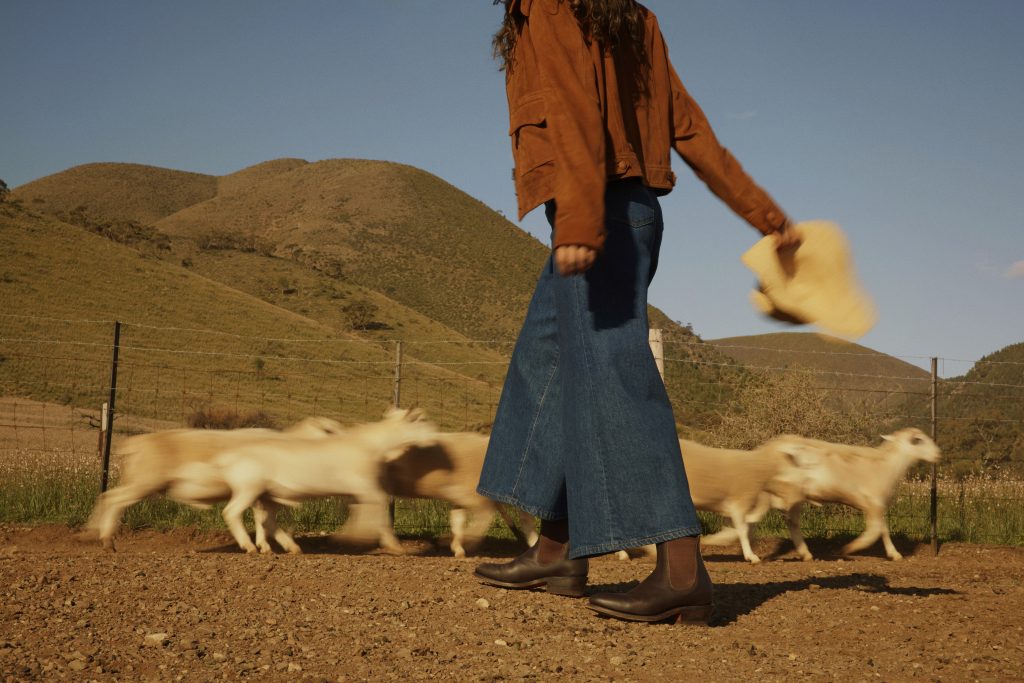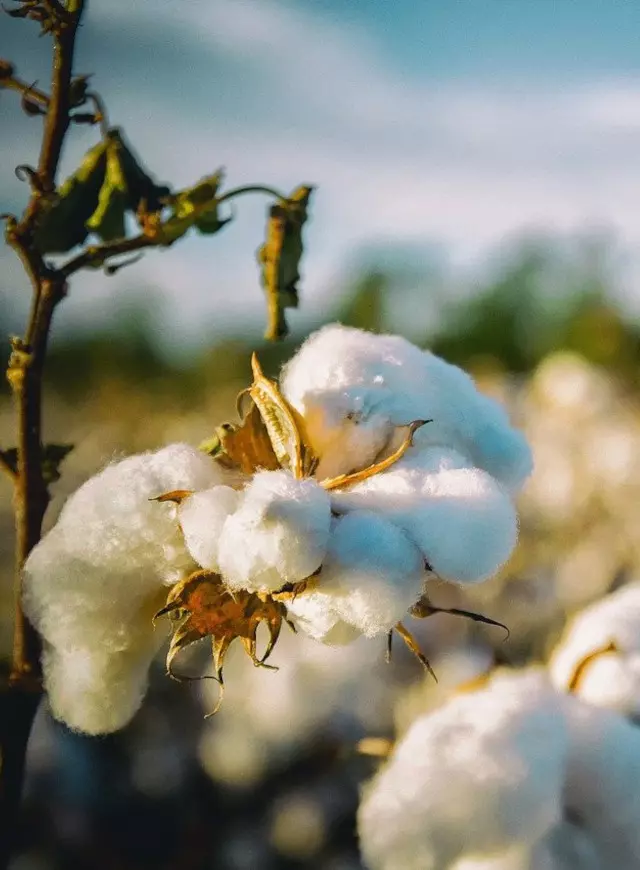In a fashion world dominated by mass production, cheap synthetic materials and ever-present digital marketing, true luxury is being redefined by a return to basic principles: the beauty and wonder of nature.
By Lucianne Tonti
“Luxury is at the intersection of nature and creativity.” It was 2021 when Antoine Arnault, the head of communications and image at Moët Hennessy Louis Vuitton (LVMH), said this, as luxury fashion’s attitude towards sustainability was undergoing a rapid transformation.
Among the upper echelons of fashion design, where products are often crafted from the rarest and finest natural materials, an existential threat to business had been identified. In a world without healthy plants and animals, there would be no cotton shirts, wool coats, cashmere sweaters, leather handbags or silk dresses.
Around the world, brands including Gucci, R.M. Williams and Loro Piana are making moves to safeguard their raw materials by protecting and restoring the farms, rangelands and forests where they are grown. The hope is that increased biodiversity and soil health will safeguard the supply of natural fibres from rising global temperatures, unpredictable weather patterns, desertification and deforestation.
The new strategy marks a step away from the usual “sustainable fashion” approaches, which focus on harm mitigation, instead moving towards regenerative practices that actively improve landscapes and livelihoods. Over the past 18 months, two global luxury behemoths—Kering and LVMH—have separately announced a range of initiatives to protect, restore and rehabilitate biodiversity, with an emphasis on implementing regenerative agriculture where raw materials are farmed.
Advocates for regenerative agriculture claim that vibrant ecologies produce more beautiful materials. In Australia and New Zealand, sheep farms that nurture grass supply alongside the careful management of native forests and their supporting ecosystems produce the world’s finest merino wool. The grass and other foliage provide a constant source of nourishment so fleece growth is smoother and more consistent. The softest cashmere comes from the undercoat of goats roaming the rangelands of Mongolia, where the difficult and wild terrain determines the fineness of the fur and herders have worked with the rhythms of the land for generations. Since luxury depends not just on the supply of raw materials but on the supply of raw materials of the highest quality, the narrative is powerful.

Bootmaker R.M. Williams is exploring plant-based leather alternatives and recently expanded its takeback, refurbishment and recycling programs.
As we race towards a future driven by mass production, cheap synthetic materials and ever-present digital marketing, true luxury is being redefined. The expendable and the artificial have been replaced by a return to basic principles and a deeper appreciation for the beauty and wonder to be found in nature. After all, on a dying planet, what could be more luxurious than taking refuge in green rolling fields, dense forests, sparkling rivers and air so clean it smells like the earth? As Francois-Henri Pinault, chairman and CEO of Kering, states: “Luxury and sustainability are one and the same.”
This shift in intentions culminated in December 2022 at COP15, the United Nations Biodiversity Conference in Montreal, where Kering—the parent company of Gucci, Bottega Veneta, Yves Saint Laurent, Balenciaga and others—joined LVMH to push for an official global biodiversity framework. Géraldine Vallejo, Kering’s sustainability programme director, told the event: “It’s the first biodiversity COP where the private sector is really present and pushing for an ambitious global biodiversity framework… We are hoping that the negotiators will agree on the level of ambition that is necessary. We also expect that next year the fashion sector will have its own dedicated stream [at the conference].”
The attendance of these fashion giants at the summit was followed by several announcements outlining new initiatives centring on biodiversity and regenerative agriculture. In partnership with L’Occitane, Kering launched a scheme to fundraise €300 million from luxury fashion and beauty companies to invest in nature conservation and restoration initiatives. The fund is also looking to help farmers transition to regenerative agriculture and support community projects promoting women’s empowerment. Meanwhile, LVMH, which controls Christian Dior, Fendi, Givenchy, Celine, Stella McCartney and Loro Piana among others, announced it would launch a program with UNESCO to restore forest cover in the southern Ecuadorian and northern Peruvian Amazon and strengthen the development of a regenerative economy in the region’s Indigenous communities.
Both announcements follow earlier commitments from the two conglomerates to use regenerative agriculture to rehabilitate millions of hectares along their supply chains.
Of course, intentions to put nature first sound poetic and persuasive, but fashion accounts for between two and eight per cent of global greenhouse gas emissions and commits a range of other environmental offences, from polluting waterways and degrading topsoil to deforestation. Given the industry’s history of using and abusing the lands and people along its supply chains, it might be hard to believe that farming raw materials could be a force for good but regenerative agriculture campaigners say it has the potential to restore damaged farmland in as little as five years. US-based global not-for-profit Textile Exchange describes the shift to regenerative agriculture as “fundamental to the long-term health of the fashion and textile industry”.
As the fashion industry grapples with reducing its carbon footprint, the term ‘regenerative’ has begun popping up with more frequency in marketing campaigns. At times, it is applied as liberally as “eco-friendly”, “sustainable” or “natural”—words with vague meanings often used by brands to greenwash their products. But when measured by clearly defined metrics, the outcomes of true regenerative farming are much less nebulous.
The simplest way to define regenerative agriculture is as a type of beyond-organic farming, a holistic approach to land management that works with nature rather than trying to control it. On a regenerative farm, traditional principles of industrial agriculture—spraying pesticides and synthetic fertilisers, tilling the soil and planting only one type of crop—are avoided. In their place, farmers use a range of techniques to improve the land across four key metrics: biodiversity, soil health, water infiltration and outcomes for communities.
A regenerative farm should look and feel wild, like a pasture with different species of plants, animals and insects all working in harmony. As in nature, where there is rarely bare soil, a regenerative farm will ensure the ground is covered at all times, reducing the soil’s vulnerability to erosion and from being dried out by the sun. Regenerative farmers plant cover crops to protect the soil, restore healthy microbial life and prevent weeds and pests. These crops are later mulched into the ground to return their nutrients to the soil.
In addition, the regenerative approach will see multiple species of complementary crops planted in the same field—perhaps chickpeas tangled beside cotton plants or tomatoes growing alongside hemp—with companion planting replacing chemical pesticides as a way to lure pests away from the main crop. Lines of trees and hedges encourage native birds and wildlife to inhabit the environment. Chickens, sheep and cattle might roam the fields, their manure fertilising the soil. The landscape should visibly and audibly brim with life.

These principles are not new. Before the invention of chemical fertilisers and farming machinery, farmers relied on natural cycles to grow their crops, with principles of land stewardship and deference to the power of nature having long been central to many indigenous communities. However, the large-scale application of these practices to fibre farming is still nascent, making the investment from Kering and LVMH significant.
Through a recent partnership with the King Charles III-founded Circular Bioeconomy Alliance, LVMH is developing a sustainable cotton production project in Africa led by regenerative and restorative principles. Commonly grown as a large-scale monocrop using industrial agriculture techniques, cotton can be especially resource-hungry, thirsty and polluting. But as we are now learning, the fibre can, in fact, be farmed in ways that enhance soil health and biodiversity.
Following a regenerative agroforestry system, the LVMH program will work with 500 farmers in Chad, northern central Africa, to plant fruit and timber trees alongside their cotton crops. Designed to improve soil fertility and water retention, provide shade and fodder for livestock, and offer a protective cover that enhances biodiversity, the trees have the added advantage of generating alternative income and subsistence for the farmers.
The notion that regenerative farming can improve the lives of farming communities is central to transforming the fashion industry’s supply chains. Potential benefits for farmers are manifold, from generating additional revenue streams and retiring expenditure on fertilisers and pesticides, to improving physical health by reducing exposure to toxic chemicals. However, the transition to regenerative agriculture takes time, and having set a target to preserve 5 million hectares of farmland by 2030, LVMH’s long-term commitment to train farmers in the principles of regenerative agriculture will be fundamental to achieving this goal.


One of Kering’s regenerative programs is a partnership with US-based organisation the Savory Institute to expand networks of holistic grazing of wool, cashmere and leather along fashion’s supply chains. While livestock can be a significant contributor to greenhouse gas emissions and a leading cause of desertification, these issues are usually the result of intensive feed-lots and “set stocking”—a grazing strategy where livestock are left in a single paddock for an extended time, eating the grass right down to its roots, causing it to die, with the soil becoming hardened and compacted as a result.
The alternative is a holistic grazing technique developed by farming pioneer and founder of the Savory Institute, Allan Savory, which has been proven to regenerate grasslands and sequester carbon into the soil. When animals such as sheep or cows are herded close together and moved on quickly, the combination of their hooves (which scuff up the grass so seeds are planted), their manure (which fertilises the soil) and their mouths (which help stimulate growth in plants) means that wool, cashmere and leather farming can all play a role in improving soil health and biodiversity while restoring habitats.
The application of Savory’s holistic grazing principles is becoming increasingly widespread, with Italian fashion house Gucci, one of the brands under the Kering umbrella, embracing the approach. The brand is working with woolgrowers in Patagonia to help convert to regenerative grazing on grasslands in a bid to promote soil health and water quality, increase biodiversity, and establish best practices for animal welfare and carbon sequestration for the long-term. Closer to home, Australian brand R.M. Williams recently set a commitment to halve the carbon footprint of its iconic boots by integrating regenerative grazing practices into its leather supply chains. Elsewhere, Italian apparel label Loro Piana has been working closely with goat herders in Mongolia and Inner Mongolia to ensure the protection of the regions’ eco-systems and native species to help maintain the quality of their cashmere.
Products of the natural world are the industry’s most essential resources; providing comfort, tactility, beauty and awe, natural fibres are the very building blocks of luxury. In 2005, then-CEO of Loro Piana, the late Sergio Loro Piana, stated that “nature is hard to reinvent”—a sentiment that is now at the heart of the industry’s focus on regenerating natural environments and protecting biodiversity. Indeed, without nature, it could be said that luxury would cease to exist. Perhaps the only surprising part of this equation is that it was ever forgotten.
